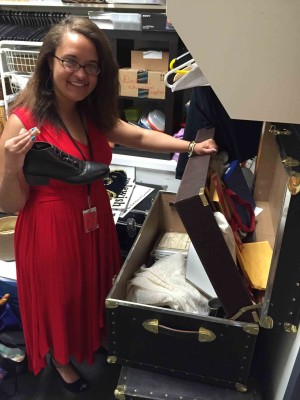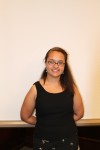Connecting the Past to the Present: Immigration Stories and Community


One of my first projects at the Jewish Museum of Maryland was to adapt the Ida Rehr immigration trunk lessons for a new program for the Girl Scouts of Central Maryland. The education department is creating new partnerships with organizations like the Girl Scouts of Central Maryland and local schools to help students learn about Jewish history, the history of the Jonestown neighborhood, and of the greater Baltimore area.
While working on the project I myself learned about Jewish immigrants’ experiences. I learned why they came to America between 1880-1924 and the Ida Rehr story. Looking through the immigration trunk and the lessons, I realized that there are some connections to immigration issues today. Ida Rehr, a Jewish immigrant from the Ukraine came to Baltimore to create a new life for herself. When she came to America she lived with her older sister and her uncle at 116 S. Bond Street, a Jewish enclave in Baltimore. She was a factory worker and attended night school to learn English and how to become an American citizen. She also married a Jewish immigrant, Daniel Rehr, at Anshe Sphard Synagogue.

Ida Rehr’s immigration story is relevant today because Baltimore still has a large immigrant population. The Education Department is modifying the immigration trunk to discuss how immigrants are adapting to life in America and Baltimore today. Discovering Ida Rehr’s naturalization papers, passport, and the process she went through in order to become an American citizen made me think about what new immigrants have to go through today. Even though the immigrants that came over in the late 1800’s were from Southern and Eastern Europe, and the new immigrants are coming from other parts of the world, they share some of the same experiences. The immigrants who are coming to America today are from many different countries. “In 2012, 11.6 million foreign-born residents—28 percent of the foreign-born population—came from Mexico; 2.3 million immigrants came from China; 2 million came from India; 1.9 million came from the Philippines; 1.3 million came from both Vietnam and El Salvador; and 1.1 million came from both Cuba and Korea.” [“The Facts on Immigration Today.” 23 October 2014.] The new immigrants that are coming to U.S. are coming for some of the same reasons that Ida Rehr immigrated to this country in the late 1800’s.
The new immigrants are coming for economic and educational opportunities, as well as political and religious freedoms. The older immigrants had to struggle with similar issues that new immigrants are facing today which include applying for citizenship, finding housing and employment, maintaining their cultural heritage, and trying to adjust to life in America.
I also learned about immigration service organizations in the city that are trying to help new immigrants and refugees become American citizens. Organizations like the International Rescue Committee, CASA of Maryland (Multicultural Center Office), Baltimore Field Office for US Immigration and Citizenship services, and Justice for Our Neighbors Baltimore Office, are trying to help new immigrants and refugees become US citizens and adjust to living in Baltimore.
I developed a lesson plan that gives the Girl Scouts an opportunity to create their own immigration trunk. Through a guided questions activity that I designed the Girl Scouts could learn more about the immigration experience in Baltimore. I enjoyed working on this project because as an intern here from New York, it helped me learn about how Baltimore is still an immigrant city today. This program also demonstrates that the Jewish Museum of Maryland is making an effort to encourage younger generations to learn about immigrants’ experiences and issues today. The museum is taking an initiative to connect immigration stories of the past to the experiences of immigrants that are living in Baltimore now. I feel honored to be involved in getting conversations going about these issues and helping the museum show their support for people in our community.
 A blog post by Education and Programs Intern Falicia Eddy. To read more posts from interns click HERE.
A blog post by Education and Programs Intern Falicia Eddy. To read more posts from interns click HERE.
